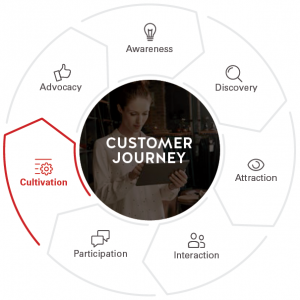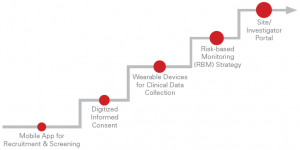If you haven’t read the previous posts in this series, be forewarned that this week’s post might be a little hard to follow, as it assumes you have all of the context from the series to-date. Still, I encourage you to dive in, and I’ll do my best to connect all of the dots for you.
In the second post in this series, I discussed the recent Duke-FDA study on investigator retention. Circling back to that study, where does it fit into the customer journey map for clinical sites from the last post, and how might you use the insights it provided to move you through the CX methodology for your sites and investigators?
Because the Duke-FDA study focused on retention, the data provides insight into the cultivation step along the customer journey map (i.e., what makes them stay with you and conduct additional trials?).
While this is only one study and represents only one step along the journey, you can still apply the CX methodology to design a cultivation-focused strategy and road map.
Let’s revisit the primary complaints:
- 8% cited workload balance
- 4% cited the time requirements
- 5% cited data and safety reporting
- 0% cited finance-related issues
This data satisfies the first step in the CX methodology: gain insights into your customers and the challenges they face in working with you. Moving into step two, the vision you develop might be to cultivate a set of highly effective, efficient, and compliant clinical sites and PIs who work with you throughout their careers. In step three, you might then develop a two-fold strategy: 1) Minimize the impact of the trial on site resources, and 2) pay sites correctly and promptly for the work that they do.
To execute that strategy, you might recognize the need for key initiatives, such as:
- Trial Operations: Incorporate digital/mobile solutions into the clinical trial process, for both subjects and site personnel
- Site Monitoring: Identify ways to make our site monitoring strategy less burdensome
- Sponsor-Site Collaboration: Implement a site/investigator portal
From there, you would move into the final of the four steps: designing a road map. At a high level, that map might look something like:
Trial Operations
- Partner with a technology company to create a mobile app for subject recruitment and prescreening
- Implement a digitized, interactive informed consent process that includes digital signatures
- Incorporate wearable devices into trials for clinical data collection, focusing first on patient vitals
Site Monitoring
- Implement a risk-based monitoring (RBM) approach
Sponsor-Site Collaboration
- Implement an investigator/site portal that includes:
- Automated notifications and reminders: documents due, documents expiring, training due, recruitment milestones approaching, payments coming
- Digital signatures and electronic document submissions: site essential documents, training records, updated versions of expiring/expired documents
- Streamlined regulatory and safety reporting: automatically compiles and formats data for required reports, integrated with regulatory authorities’ reporting gateways
- Charts and graphs for quick visual snapshots: subject enrollment and statuses vs. targets, compliance with required documents, site performance scorecard
- Automated workflows, including payment inquiries/claims: ability to open a claim against a payment with automated claim resolution for common issues
Remember that these are just examples; your customer insights, strategy, key initiatives, and road map might look vastly different for your specific circumstances. But, I hope this use case has helped you connect the dots between reframing your clinical sites as customers and applying the CX methodology to shape the way you engage with your investigators to increase retention, satisfaction, and productivity, ultimately reducing clinical trial costs.
In my next and final post in this series, I’ll summarize the key takeaways of the series, and also point you to some additional relevant resources. While you wait, here’s our guide on this topic.
See you next time for the wrap-up!



